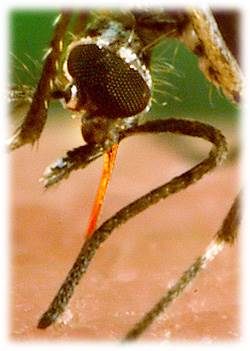Form, Function, and Adaptation
Aedes aegypti, being the most successful vector for the dengue fever and yellow fever virus, is highly adapted to almost all forms of human and natural habitats. At the anatomical level, mosquitos have three key features that allow them to exceed in their environmental niche.
Club-shaped Wings
Mosquitos of all varieties, A. aegypti species included, possess the ability flight through a pair of filmy wings that are located on the dorsal side of their thorax. Almost everything A. aegypti is allowed to accomplish is in direct response from its aviation abilities. A. aegypti has been recorded to have been capable of travelling a flight distance of 580 meters from its spawning site. Within this flight radius, a mosquito is able to lay numerous eggs which will give birth to new larvae. As those larvae mature into adult mosquitos, they too can take advantage of their wings and potentially house their eggs in a number of potential breeding sites far away from their own breeding site. With A. aegypti populations spread across far distances, some mosquito populations may be choked off from interacting with the original mosquito populations from the origin areas. Thus flight has allowed for A. aegypti populations to develop their own unique genetic strains to match their own distinct habitats (Gorrochotegui-Escalante et al., 2000). Such genetic adaptations can be seen in certain A. aegypti populations where they have evolved a resistance to DDT or other control chemicals in response to natural selection.
Proboscis
 The proboscis is another major
feature of A. aegypti and is what is directly responsible for
their proficiency in both breeding and functioning as a
disease
vector. In order for A. aegypti eggs to properly develop, a
blood
meal is required for proper growth. Female mosquitos acquire this
proper blood meal through the use of their proboscis which is,
more-or-less, a biological syringe. Mosquitos are capable of “biting”
many species of animals, typically within the mammalian group, by
injecting their proboscis within the skin of an animal and
withdrawing blood into a specialized storing cavity in their
abdomen. This blood drive is related closely related to oogenesis,
or the development of ova, as
the female mosquitos metabolize a victim’s blood and produce a
protein meal supplement which allows egg cells to mature
(Lavoipierre, 1961).
The proboscis is another major
feature of A. aegypti and is what is directly responsible for
their proficiency in both breeding and functioning as a
disease
vector. In order for A. aegypti eggs to properly develop, a
blood
meal is required for proper growth. Female mosquitos acquire this
proper blood meal through the use of their proboscis which is,
more-or-less, a biological syringe. Mosquitos are capable of “biting”
many species of animals, typically within the mammalian group, by
injecting their proboscis within the skin of an animal and
withdrawing blood into a specialized storing cavity in their
abdomen. This blood drive is related closely related to oogenesis,
or the development of ova, as
the female mosquitos metabolize a victim’s blood and produce a
protein meal supplement which allows egg cells to mature
(Lavoipierre, 1961).
Johnston's Organ
One last major anatomical feature within A. aegypti is the antennae, or more specifically the Johnston’s organ between the pedicel and flagellum of each antenna. The Johnston’s organ is essentially a directive organ that allows a mosquito to register vibrations from its surrounding environment (Christophers, 1960). This sensory organ thus not only makes it possible for a mosquito to travel unhindered, but it lets mosquitos hone in on sound sources through the vibration waves given off. Locating these sources of sound vibrations is critical in the process of acquiring a blood meal.


